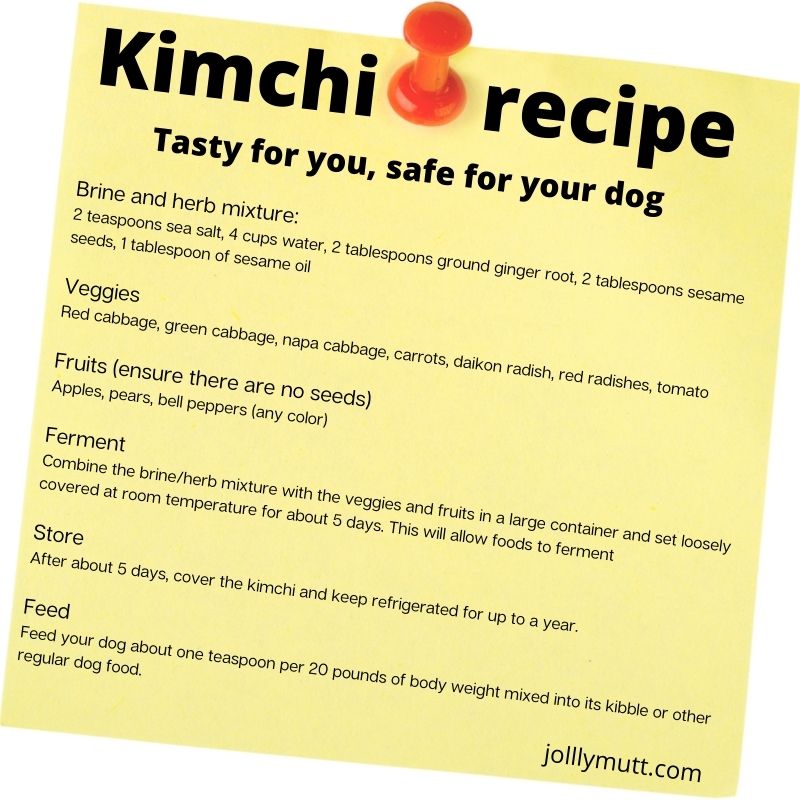
It never fails. You sit down to have a bite of something, and your dog is right there, staring you down with that longing look, begging for a taste. If you’re like me, you’ll usually share just a bit. But what if you’re eating kimchi? Is that ok? Can dogs eat kimchi safely?
The short answer is almost always, “Yes, kimchi is safe for your dog to eat”.
But, there are considerations so please read through to get all the details before you give Fido that steaming bowl of kimchi.
We also provide a quick and easy dog-friendly kimchi recipe
Take a look at the recent craze in Korea, known as “Mukbang”, which are viral eating shows that are gathering 10’s of millions of viewers every day. Here’s one with dogs eating kimchi. I like this as it shows that the kimchi is free of garlic and onion, so is OK for dogs
What is kimchi?
First, let’s address the spelling. It may seem trivial, but it isn’t. You’ll see it spelled as “kimchi” in this article, but you’ll see it spelled kimchee elsewhere. Sometimes it’s referenced as kimuchi. Kimchee is the original Korean word and is still used today in Korea. Elsewhere it’s become standard to reference it as kimchi. Many Koreans consider this a misspelling of kimchee and may be offended by it. However, as “kimchi” is the standard, I’ll use it here.
Kimchi is a common side dish in Korean cuisine and is a staple in Korean food. Typically made from fermented vegetables such as cabbage and radishes, in addition to a variety of spices and seasoning. The resulting pungent concoction is both tasty and immensely healthy for humans.
But what about our furry friends?
Is kimchi safe for dogs?
To determine this, we need to explore the two main aspects of kimchi: Vegetables and fermented food.
We should look at each to determine if kimchi is safe for dogs to eat.
Are vegetables safe for dogs?
We have a number of other articles on our pages here at JollyMutt that discuss what is and what is not safe for dogs to eat. Most veggies are safe, but, importantly, some are not.
Kimchi is almost always associated with fermented cabbage, but there are variations where cabbage is not used, and other fermented veggies are. However, most often, cabbage is used, but it can be accompanied by various other types of vegetables, so it’s important to look at them individually to determine if they are safe for dogs to eat.
Garlic and onions, for example, are often used in kimchi. Garlic and onions can be toxic for dogs and are listed on our nine most dangerous foods for dogs chart.
To be fair, they are not usually present in high enough amounts to be dangerous.
Still, though, why take the chance?
Take a look at our main “health” page to get a sense of what is and is not safe for dogs to eat and also a look at the 9 most dangerous foods for dogs.
Is fermented food safe for dogs?
Dogs need healthy guts as much as we do.
In fact, with the amount of scavenging they do, it’s safe to say they may need this more than humans. Actually, some of this scavenging results in them eating fermented food as well.
They’re outside eating an old thrown-out sandwich, deer poop, and maybe a snack or two from the trash when you aren’t looking. Wild dogs and cats take this further and even eat other dead animals. It’s not pleasant to think about, but the stomach contents of the animal being eaten are the most prized part. Interestingly, those stomach contents are typically fermented, so wild dogs and cats get plenty of fermented food this way, along with all the associated beneficial bacteria.
Before dogs became domesticated, they would obtain a percentage of their vegetable roughage, phytonutrients, and antioxidants from what they consumed in their prey’s digestive organs.
Essentially, they were getting fermented foods from their prey’s partially digested stomach contents.
Think about probiotics and how helpful they are for humans. Same for dogs. Probiotics are helpful for them as well.
Fermented food is loaded with probiotics.
For our dogs, probiotics, such as those found in kimchi, help to promote health in the way they piggyback on the inherent relationship between the immune system and the all-important microbes.
We have learned a lot about how our immune cells attack invading pathogens. In fact, probiotics are responsible for producing antibacterial compounds that actually inhibit our tolerance for pathogen growth.
In simple terms, the “good bacteria” in probiotics eliminate the bad while making it harder for the bad bacteria to propagate.
Of course, this process is best established while healthy and not after one gets sick. This is why it is advised that while your dog is well, get her started with a diet rich in good microflora.
There are potent chelators and detoxifiers in fermented vegetables that help rid the body of a wide range of toxins, not the least of which are heavy metals.
You will also find essential vitamins such as C, B complex, and K2, along with enzymes, which help to produce the essential amino acids choline and acetylcholine.
Another advantage is the lactic acid produced as a result of fermentation. This chemical repressor is instrumental in fighting cancer cell growth without sacrificing any healthy cells.
Yes, fermented food is safe for dogs (as long as the food itself is not dangerous to dogs)
What else is in there?
Kimchi can be a true hodgepodge of whatever you have lying around when you are making it. If your dog ends up eating some, you should be mindful of what is added to ensure you are not adding ingredients that could end up harming the dog either from toxicity or just things that are generally bad for dogs, such as spices, salt, etc.
Soy sauce is common in oriental dishes and is usually extremely high in sodium. This is a good example of an ingredient that can cause kimchi to be bad for dogs.
What about spicy kimchee?
When I think of kimchi, I immediately go to spicy food for some reason. Perhaps something in my past. It seems I remember something about a bowl of kimchi laced with sriracha, and I wasn’t quite prepared for it then.
But kimchi is not always spicy and, in fact, by default, is usually not.
But sometimes it is. It’s important to note that spicy foods should never be fed to dogs as their stomachs are not equipped to handle spicy foods.
So no, spicy kimchi should not be fed to dogs.

Health Benefits of Kimchi for your dog
Kimchi is complicated.
There are a lot of ingredients that can go into it, and each of those will bring its own unique health benefits.
I’d like to discuss the benefits of fermented food overall rather than kimchi specifically. However, since the essence of kimchi is a fermented food, it makes sense to outline this here.
Studies show there are numerous benefits to be gained by your dog by eating fermented food:
- Improved weight management
- Improved immune system
- Improved protection against parasites
- Improved dental health
- Improvement in the stabilization of blood sugar
- Improved and healthier bowel movements
- Improved post-operative recovery due to fewer infections
The above is what fermented food does for humans and dogs. It’s probably not a terrible idea to share a bit with Fido every now and then.
Understanding how a dog’s digestion is different from humans
Since we’re talking about feeding your dog vegetables, and we established above that most vegetables are, in fact, good for dogs, it’s interesting to note that your dog’s body isn’t exactly made for processing veggies.
The first thing is the teeth. Humans’ teeth are long and flat, making it easy to bite and chew vegetables. Dog teeth are long and sharp, made for eating meat.
The digestive tract is the next consideration. Vegetables and other high-fiber food take a long time to digest, so the human digestive tract is quite long. About 20x longer than a dog’s. The dog’s digestive tract is not made for digesting veggies. Meat and other typical food dogs eat are more easily digestible. For this reason, if you look at your dog poop (and you should!), you’ll often find undigested bits of vegetables. This is entirely fine and expected.
Introduce your dog to Kimchi
So to the question, “Can dogs have kimchi,” the answer is yes. You may have to start small, with only a portion of a teaspoon at first mixed in their food to see if they enjoy the taste.
If your dog likes it and its body accepts it, you can gradually increase it from one to three teaspoons per 20 pounds of body weight.
Certainly, don’t try to force the veggies onto your pet, who clearly shows that they will have none of it. We find offering a bit to dogs as younger puppies to acquire them to the taste will make it easier. An adult dog may not find the smell or taste palatable.

Kimchi recipe for your dog
- Brine and herb mixture:
- 2 teaspoons sea salt
- 4 cups water
- 2 tablespoons ground ginger root
- 2 tablespoons sesame seeds
- 1 tablespoon of sesame oil
- Veggies
- Red cabbage, green cabbage, napa cabbage, carrots, daikon radish, red radishes, tomato
- Fruits (ensure there are no seeds)
- Apples, pears, bell peppers (any color)
- Ferment
- Combine the brine/herb mixture with the veggies and fruits in a large container and set loosely covered at room temperature for about five days. This will allow foods to ferment.
- Store
- After about five days, cover the kimchi and keep it refrigerated for up to a year.
- Feed
- Feed your dog about one teaspoon per 20 pounds of body weight mixed into kibble or other regular dog food.
Here’s an image of the doggy friendly kimchi recipe to print out and hang on your fridge:

Can dogs eat other vegetables?
Certainly!
As with kimchi, this should be done sparingly and should not constitute the bulk of any of your dog’s meals, but veggies such as bell peppers, olives, edamame, or jicama are great snacks for your pup. Again, in moderation.
We have created a comprehensive list of foods your dog should and should eat: Can dogs eat…? 75+ food items reviewed
Conclusion: Can dogs have Kimchi?
As long as the individual ingredients used are not bad for dogs, kimchi is a great addition to a dog’s diet. Be careful of those ingredients and avoid items that can be inherently toxic to dogs, such as garlic and onions.
We often hear, “Can dogs eat [fill in the blank],” so we are working on a series of articles to discuss these topics. Please see our additional articles on our main page, where we publish various articles about your pup’s health.
Also, for a more informative overview of what your dog should and should not eat, be sure to take a look at our “Can dogs eat?” article, where we cover over 80 different items.
